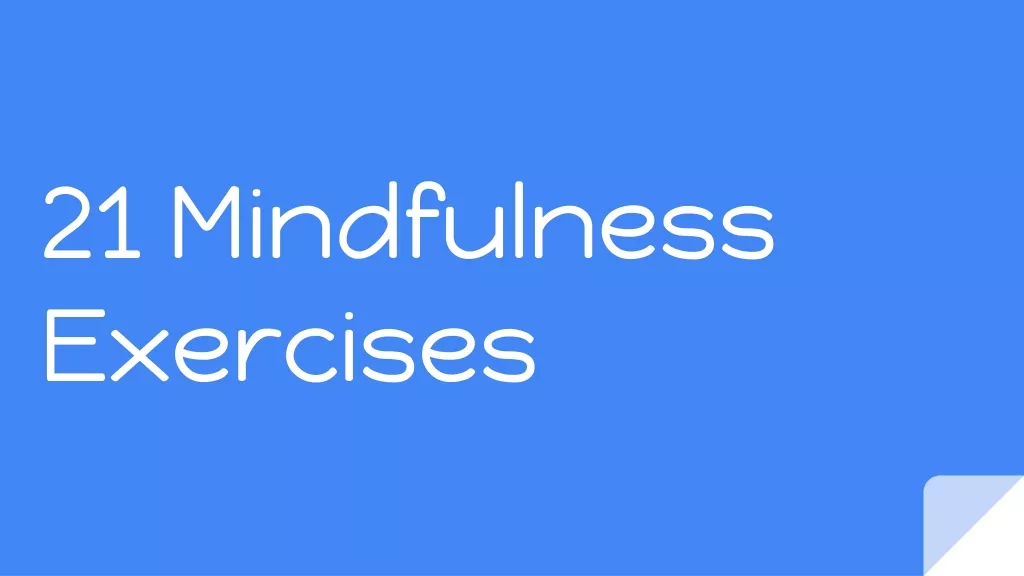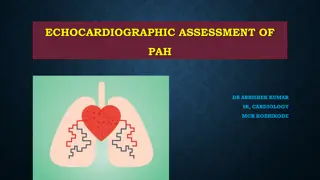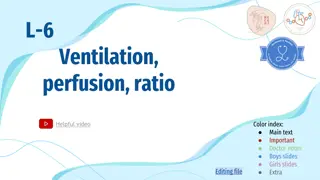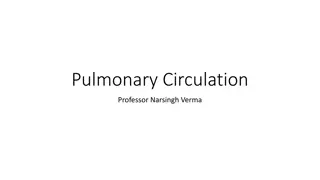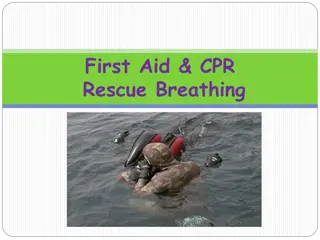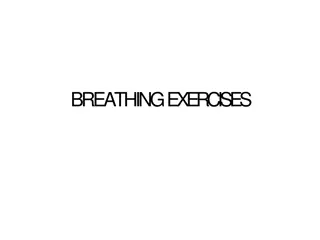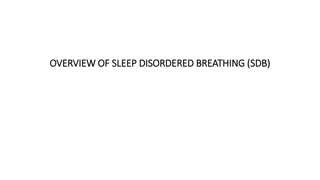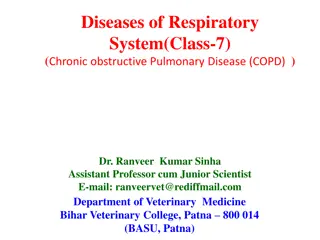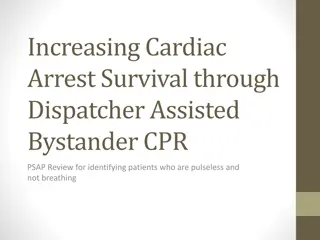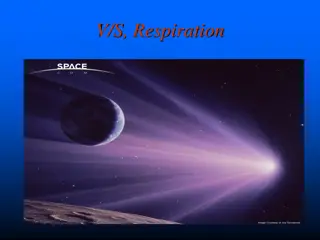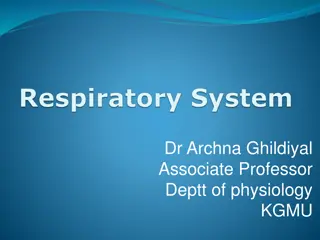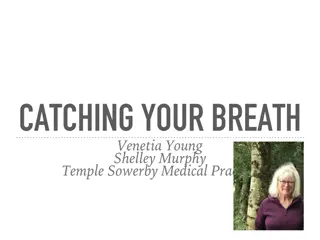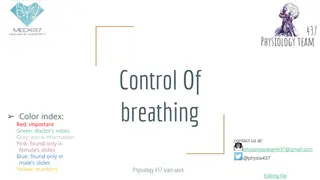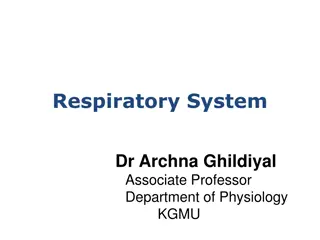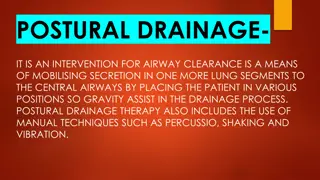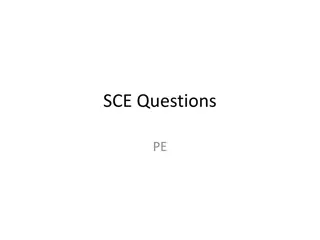Breathing Exercises for Pulmonary Health
Breathing exercises are essential interventions for managing pulmonary disorders like COPD, cystic fibrosis, and post-operative complications. They help improve ventilation, cough effectiveness, muscle strength, and reduce stress. Different types of exercises like diaphragmatic breathing and pursed lip breathing can be performed under proper guidance to enhance lung function and overall well-being.
Download Presentation

Please find below an Image/Link to download the presentation.
The content on the website is provided AS IS for your information and personal use only. It may not be sold, licensed, or shared on other websites without obtaining consent from the author.If you encounter any issues during the download, it is possible that the publisher has removed the file from their server.
You are allowed to download the files provided on this website for personal or commercial use, subject to the condition that they are used lawfully. All files are the property of their respective owners.
The content on the website is provided AS IS for your information and personal use only. It may not be sold, licensed, or shared on other websites without obtaining consent from the author.
E N D
Presentation Transcript
BREATHING EXERCISES Breathing exercises and ventilatory are fundamental intervention for the prevention or comprehensive management of impairments related to acute and chronic pulmonary disorders. For eg. COPD, cystic fibrosis, patient with a high spinal cord lesions, patient undergone thoracic and abdominal surgery, bed ridden patient etc.
Indications- Improve or redistribute ventilation. Increase the effectiveness of the cough mechanism and promote airway clearance. Prevent post operative pulmonary complications. Improve the strength and endurance and coordination of the muscles of ventilation. Maintain or improve chest and thoracic spine mobility. Correct inefficient or abnormal breathing patterns and decrease the work of breathing. Promote relaxation and relief stress. Improve the patient s overall functional capacity for daily living. Teach the patient how to deal with episodes of dyspnoea.
Contraindications Never allow a patient to force expiration. Expiration should be relaxed and lightly controlled. Don't allow a patient to take a highly prolonged expiration. Don't allow a patient to initiate inspiration with the accessory muscles and the upper chest. Allow the patient to perform deep breathing for only 3 or 4 inspirations and expirations at a time to avoid hyperventilation. Recent neurosurgery Severe hypertension Unstable angina Recent myocardial infarction
Cardiac Arrythemia Pulmonary embolism/pleural effusion. Congestive heart failure Pulmonary oedema Severe Haemoptsis
Types of Breathing Exercises 1. Diaphragmatic breathing 2. Segmental breathing a. Lateral coastal expansion b. Posterior basal expansion 3. Pursed lip breathing 4. Respiratory resistance breathing a. Inspiratory resistance training b. Incentive Respiratory spirometry 5. Glossopharyngeal breathing
1.Diaphragmmatic breathing- This is designed to improve the efficiency of ventilation, decrease the work of breathing, increase the exertion of diaphragm and improve gas exchange and oxygenation. Procedure- Prepare a patient in a comfortable and relaxed postion in which the gravity assist the diaphragm such as Semifowler s position. If patient initiates the breathing pattern with the accessory muscles of inspiration. Start instructions by teaching the patient how to relax those muscles. Place your hand on rectus abdominis just below the anterior coastal margin. Ask patient to breathe in slowly and deeply through nose then tell the patient to relax and exhale slowly through mouth. Have the patient practice this 3-4 times and then rest.
Don't allow the patient to Hyperventilation. If the patient is having difficulty using the diaphragm during inspiration have the patient inhale several times in succession through the nose by using a sniffing. To learn how to self monitor have the patient place his own hand below the anterior coastal margin and feel the movement. The hand should rise slightly during inspiration and fall during expiration. 2.Respiratory resistance training- A. Inspiratory resistance training- It is designed to improve the strength and endurance of the muscles of inspiration and decrease the inspiratory muscles fatigue.
Procedure- The patient through a resistive hand training device place in the mouth called as Resistor. The patient inhales through the device for a specified period of time several times a day. The time is gradually increased to 20-30 minutes at each training session to increase inspiratory muscles endurance. B. Incentive respiratory spirometry- It is a form of ventilatory training that emphasizes sustained maximum inspiration. The patient inhales as deeply as possible. The purpose of incentive expirometry is to increase the volume of inspired air. It is primarily used to prevent alveolar collapse.
Procedure- Have the patient assume a comfortable position and inhale and exhale 3-4 times and then exhale maximally with the fourth breathe. Then have the patient place the expirometer in the mouth inhale maximally through the mouth piece and hold the inspiration for several second. The sequence is repeated 5-10 times several times a day.
3.Pursed lip breathing- This breathing pattern often is adopted spontaneously by patient with COPD to deal with episodes of dyspnoea as it helps decreasing their level of exertion during activity. 4.Segmental breathing- There are some conditions in which hypoventilation does occer in certain areas of the lungs because of chest wall fibrosis. Pain and muscle guarding after surgery, etelectasis and pneumonia
A. Lateral coastal expansion- Also called as lateral muscle expansion can be carried out unilaterally or bilaterally. This technique is particularly important for the patient with a stiff lower rib cage as in chronic bronchitis, emphysema or asthma. Procedure- Have the patient begin in a hook lying position later progress to sitting position. Place the hand on the lateral aspect of lower rib to direct to patient to areas where the movement is to occur. Ask the patient to breathe out and feel the rib cage move downward and inward as the patient breathes out, place pressure into the ribs with the palm of your hand.
Just prior to inspiration apply a quick downward and inward stretch this places a quick stretch on the external intercoastal to facilitate their contraction. Teach the patient how to perform the maneuver independently by placing his or her hands over the ribs and applying resistance with a towel or belt around the lower ribs. B. Posterior basal expansion- Deep breathing emphasizing posterior basal expansion is important for posterior surgical patients who is confined to bed for extended period of time because secretions often accumulate in the posterior segments of the lower lobes. Procedure- Have the patient sits lean forward on the pillow slightly bending the hips place your hands over the posterior aspects of lower rib cage and follow the same procedure for lat. muscle expansion.
5.Glossopharyngeal breathing- Its means of the increasing the inspiratory capacity when there is severe weakness of the inspiratory muscle. Procedure- Glossopharyngeal breathing involves taking several gulps of air usually 6 to 10 gulps in series, to pull air into the lungs when action of the inspiratory muscles is inadequate. After the patient takes several gulps of air, the mouth is closed and the tongue pushes the air back and traps it in the pharynx. The air is then forced into the lungs when the glottis is opened. This increases the depth of the inspiration and the patient s inspiratory and vital capacities.


